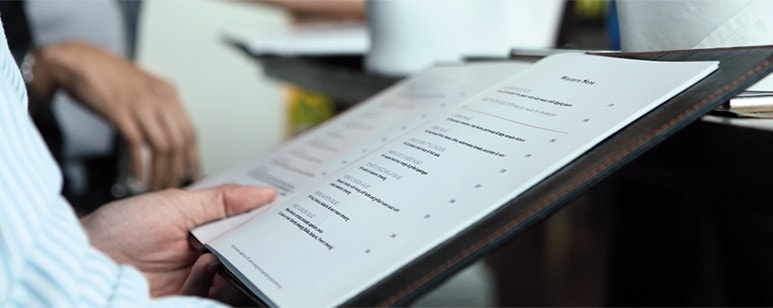Maximising Efficiency – Your Menu and Kitchen
Learn how to optimise your menu and kitchen for better profits and productivity.

Maximising Efficiency and Profit

Your menu
Cost-effective menu planning helps guide the target market for your business. It decides the:
- Manpower needed
- Preparation methods used in the kitchen
- Time needed to serve
All in all, it plays a large part in determining the amount of capital needed for operating a restaurant. How can we make this menu more cost-efficient?
Ingredients
- Control ingredient costs by creating a target of 30% of food selling price to ensure profitability. However, remember to maintain the quality of your dishes.
- Ensure kitchen staff are cost-conscious and understand recipe costing to allow consistency in a dish’s taste and price.
- Learn market conditions, food supplies and cost-effective solutions from food suppliers.
- Use what is in season as it is abundant and thus, cheaper.
- Make the most of regional ingredients as they can cost less and diners will be more familiar with such ingredients, leading them to order more.
- Explore using common ingredients in dishes to maximise its use.
Methods
- Use methods that minimise cooking loss. Some ingredients may lose yield based on cooking methods. As a general rule, cooking meats at a low temperature gives you a higher yield and cooking seafood quickly at higher temperatures gives you higher yield.
- Methods that minimise manpower also mean minimised costs. Consider taking advantage of ready-to-use products that are now easily available in the market to replace basic recipes and bases.
- Learn more about maximising yield and basic costing in the Counting Costs module.

Your kitchen
There are several elements in the kitchen that can be run more efficiently such as purchasing and logistics, inventory management, kitchen layout and equipment, and clear work organisation. Let’s look at each area in more detail:
Purchasing and logistics
- Seek out established professional suppliers with a good reputation.
- Test out the quality of their products before making big purchases.
- Look for consistency in quality, delivery and cost. It’s important to look at their reliability, not just the price.
Inventory management
- Create standard operating procedures and fixed schedules for ordering to avoid last minute scrambles.
- The person ordering should be hands-on in the kitchen so they know the stock levels for different ingredients and their rates of use.
- Institute cut-off times for staff to submit requisition requests each day.
- Train staff to receive and process ingredients.
- When receiving ingredients, weigh, inspect and store food immediately.
- Observe shelf life and use a First In, First Out (FIFO) system for all stock.
Kitchen layout and equipment
Know what type of kitchen fits your operations:
- Quick service restaurants are characterised by speed and high-volume activity.
- Hotel food service or catering requires a huge kitchen as well as satellite kitchens that have mobile holding equipment.
- Mid-scale restaurants can function with a medium-scale, hotel-style kitchen.
- In-flight food service kitchens operate around the clock and are usually located near the airport.
Lay out the kitchen to ensure a smooth flow:
- The receiving and storing area should be close to each other, and they should be near the drop-off point for supplies.
- The area next to storing should be the mise en place (area where you prepare ingredients and utensils before cooking) and production/cooking area for easy retrieval.
- After food is cooked, it should be moved to the plating and pick-up area, close to the dining room.
Invest in more energy-efficient equipment and fittings to save costs, and adopt a more efficient mode of operations:
- Turn off fans, air-conditioning and other electric appliances at the end of the day.
- Create a regular maintenance schedule to make sure that the components of your equipment – such as temperature knobs, thermostats and refrigerator or freezer door gaskets – are checked and replaced regularly.
Clear work organisation
- Have clear roles for each staff member so responsibilities are not duplicated. This creates greater work satisfaction as they understand their roles better.
- Efficient work schedules allow you to maximise your manpower. This means not overstaffing during quiet periods or understaffing at peak periods. As a general rule of thumb, have only 40% of your staff during off-peak hours and 100% during peak meal periods.

Congratulations, you’ve completed the Maximising Efficiency: Your Menu and Kitchen topic!
Continue on to the next topic, pick a related topic from the Maximising Efficiency and Profits module, or go back to the Chefmanship Academy modules page.
What you'll get:
- Access to free Chef trainings
- The best recipes and tips from Chefs around the world
- The latest culinary trends


